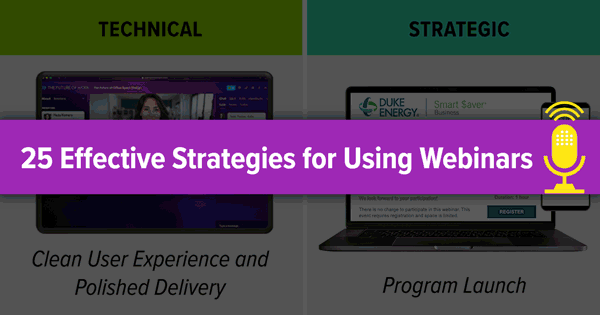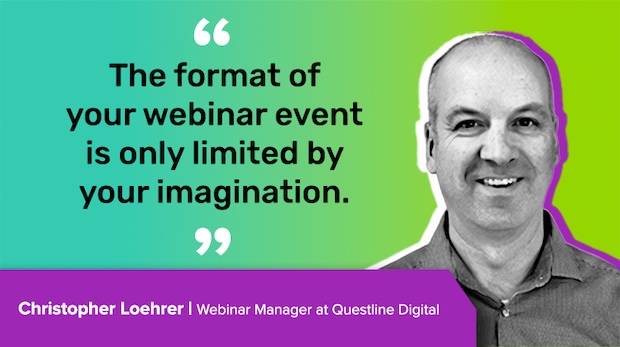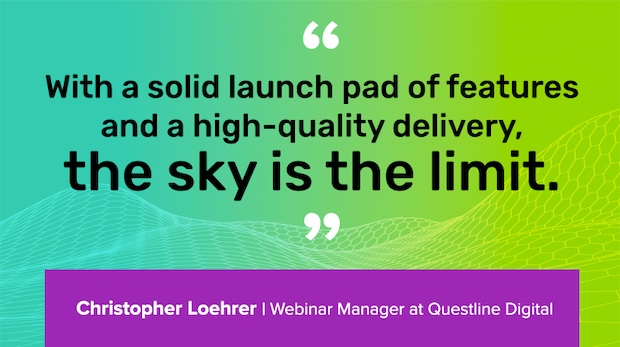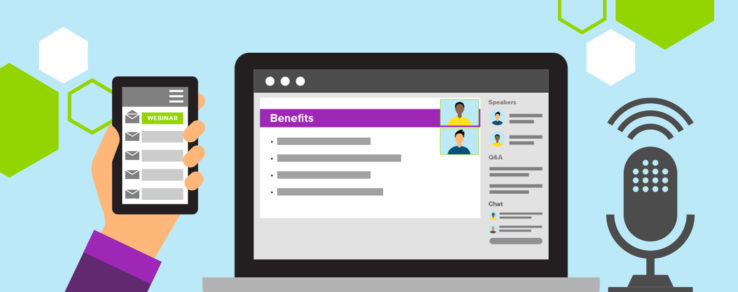Companies everywhere, including utilities, are seeking innovative ways to engage customers and build lasting relationships. One powerful tool that has evolved leaps and bounds in the past five years is the online webinar. With their ability to connect businesses directly with customers in real-time, webinars have become an invaluable resource for utilities looking to maximize customer engagement.
Utility webinars offer a unique platform to educate, inform and connect with customers and employees. By hosting webinars, utilities can deliver valuable content directly to their target audience, providing them with insights and solutions tailored to their specific needs. Whether it’s educating customers on energy-saving practices or showcasing new industry technologies to employees, utility webinars offer an interactive and engaging way to share knowledge.
One of the key advantages of webinars is their ability to foster direct interaction between utilities and customers or employees. Unlike traditional marketing channels, utility webinars enable two-way communication, allowing customers to actively participate, ask questions and get instant responses. This level of engagement not only enhances customer satisfaction but also builds trust and loyalty. Additionally, webinars provide utilities with valuable feedback, helping them understand customer preferences, concerns and pain points, which can be used to refine products, services and messaging strategies.

“It’s time to break free from one-directional presentations where a presenter speaks at the audience,” says Christopher Loehrer, Webinar Manager at Questline Digital. “Rather, organizations need to embrace the conversational aspects of webinar events. Think about how podcasts engage with their audiences by having conversations with other subject matter experts; ask for audience participation. The format of your webinar event is only limited by your imagination.”
There are many ways utility webinars can be used to foster engagement and achieve educational and training objectives. Let’s dive into 25 effective strategies utilities can use to harness the power of webinars.
Strategic Ways to Use Utility Webinars
There are a variety of ways to think about how to leverage the advantages of webinars. Strategically using webinars means that you’re adding them into your content mix or marketing plan to help your utility reach its goals, whether improving education or increasing program enrollments.
When you’re considering the technical implications of utility webinars, you must consider the features that occur behind-the-scenes. These capabilities help increase traffic to your webinar or improve engagement throughout the event.
“Attendees expect your presentations to be informative, engaging, relatable and entertaining,” says Loehrer. “Think about what captures your attention at in-person events and sprinkle that into your webinar to increase engagement and conversion.”

Some strategic ways to use utility webinars include:
1. Educational Webinars: Your utility’s marketing or program teams can host webinars to educate customers about water conservation tips, renewable energy options or new industry technologies. Additionally, educational webinars are a great way to train utility employees about trends or best practices they should be aware of.
2. Product Demos: Webinars can be used to showcase new products or services offered by your utility, providing customers with a detailed demonstration and answering any questions.
3. Customer Q&A Sessions: Utility webinars can be designed as interactive sessions where customers can ask questions about their bills, conservation strategies or any concerns they may have.
4. Efficiency Workshops: These webinars can focus on providing customers with practical tips and strategies to improve energy efficiency or water conservation in their homes or businesses, helping them save money and reduce their carbon footprint.
5. Program Launches: Webinars are an effective platform to introduce new utility programs or initiatives, including rate plans or billing options, explaining the benefits and encouraging customer participation.
6. Case Studies: Utility marketers can use webinars to share success stories of customers who have achieved significant energy or water savings or implemented sustainable practices. By highlighting these case studies, it may encourage other customers to adopt your utility’s programs or services.
7. Industry Expert Interviews: By inviting experts to speak as guests during webinars, your utility can provide valuable insights and new perspectives to customers and employees. This is also a way of keeping customers or employees informed about the latest trends and advancements inside and outside the industry.
8. Community Engagement: Webinars can be utilized to engage with local communities, addressing specific challenges and soliciting feedback or suggestions from customers.
9. Sustainability Initiatives: Leverage webinars to highlight your utility’s sustainability efforts, showcasing its commitment to renewable energy, water conservation or environmental stewardship. Explain in a thoughtful way how your utility is working to reach its sustainability goals and how these goals affect customers.
10. Conservation Challenges: Remember: webinars are fun! Try hosting energy or water conservation challenges via webinars to encourage customers to participate actively in reducing their consumption, offering incentives and rewards for achieving specific targets.
11. Customer Testimonials: Invite satisfied customers to join your utility’s webinars and share their experiences. Hearing first-hand from customers who have benefited from programs or services can encourage other customers to sign up. This is a great way to build trust and credibility.
12. Collaborative Partnerships: Webinars can be used to promote your utility’s partnerships with organizations or businesses in the community, showcasing joint efforts in promoting sustainability and conservation efforts.
13. Rebate Programs: Use webinars to provide customers with detailed information about available rebate programs, explaining eligibility criteria, application processes and the potential savings.
14 .Resource Roadmaps: Webinars can serve as a platform to present your utility’s long-term plans for a clean and sustainable future, keeping customers informed about future energy and water resource plans and resilience initiatives.
15. Virtual Tours: Organize online tours of customers’ facilities, renewable energy installations or water plants through webinars, giving customers an inside look into the operations and showcasing their commitment to sustainability.
One Southeast energy utility used webinars to empower its account managers with training and education events. With a one-person training team and busy internal subject matter experts (SMEs), the utility didn’t have the time or resources to produce quality educational assets for its 300 employees. By including webinars in its strategy, the utility was able to build a robust training program and educational library for its employees, all without exhausting the organization’s resources.
Another utility, Duke Energy, incorporated webinars into its sales strategy as a way to inform customers and encourage new sales of its programs and services. By creating webinars that catered to customers’ interests and needs, the utility was able to not only sell to its customers but educate them about the benefits of its programs. This program exceeded webinar attendance benchmarks and Duke noticed a dramatic increase in customer engagement and J.D. Power ratings since beginning the webinars.
Building Engagement with Advanced Webinar Technology
Effective educational content is key to hosting a successful webinar. But just as important are the technical features of a webinar platform. These capabilities can provide exceptional user experiences and make attendees want to come back for more.
“With a solid launch pad of features and a high-quality delivery, the sky is the limit,” says Loehrer. “Be sure to gather as much information about your attendees as possible to ensure you deliver the right message to the right viewers with these options.”

Some considerations to make about the technical capabilities of utility webinars include:
16. Interactive Tools: Utilities should have access to interactive features that encourage active participation. These tools also allow your utility to gather valuable data throughout the event. Some of these features might be a chatbox, polls and surveys, live emoji reactions, quizzes, and breakout rooms for smaller group discussions.
17. Screen Sharing and Annotation Tools: The ability to share screens during webinars allows utilities to present slides, demonstrate software or showcase visuals. Additionally, your utility may want to have whiteboard and annotation tools to facilitate real-time collaboration and illustrate concepts.
18. Cross-Promotion Tactics: A webinar platform that allows pop-up offers or banners to share more information about your utility’s programs is a great way to redirect attendees to your utility’s current offerings.
19. Professional Attendee Journey: An effective registration system and scheduling tool are essential to managing participant sign-ups and sending out reminders for upcoming utility webinars.
20. Recording Capability: An on-demand version of your utility’s webinar enables utilities to capture the session for later playback and is a valuable way to share the information with those who couldn’t attend the live event. The recording can also serve as a reference for those who did attend and wish to review or share the event with others.
21. Presentation Format: Many utility webinars are presented in a typical fashion with one speaker and a presentation deck. Consider new formats like roundtable conversations, ask-the-expert discussions, and interviews with subject matter experts to further the conversation and retain attendees’ attention.
22. Clean User Experience and Polished Delivery: As a professional organization, it’s imperative to highlight this any time you’re communicating with customers or employees. Ensure that the webinar environment you’re using is clean and easy to use for participants. The webinar platform itself should be well-suited to handle high-definition delivery, play pre-loaded videos and switch between multiple presenters and presentations seamlessly. Plus, don’t forget to include your brand colors and logo to keep your webinars consistent with other communications.
23. Webinar Series: Webinar series that are delivered on a consistent schedule helps your utility stay top-of-mind with attendees. As you continue to produce webinars, you may find some topics resonate with attendees more than others. The ability to adjust webinars as the year progresses is also an important capability.
24. Analytics and Reporting: Robust reporting capabilities provide utilities with insights into attendance rates, engagement levels and attendee feedback to evaluate the success of their webinars. Remember: The key to measuring success is knowing what works and what doesn’t.
25. Accessibility: Accessibility comes in many forms. Make sure your utility webinar is accessible for viewers on desktop or mobile devices, in multiple languages and with closed captioning features so that all attendees have the best experience possible.
These technical features help to create a dynamic and engaging webinar experience for both utilities and the audience, fostering effective communication and knowledge sharing.
National Grid and Eversource effectively used technical features that contributed to successful webinars. As many Americans struggled to make utility payments during the COVID-19 pandemic, the two utilities partnered to get the word out about their available financial assistance programs. They worked with Questline Digital to produce a series of educational webinars.
To accommodate the varying needs of customers, the webinars were produced with closed captioning and broadcast separately in Spanish and Portuguese. The webinars also included video of an American Sign Language (ASL) interpreter. By incorporating these features, the utilities were able to reach a broader audience. In fact, the language accommodations were met with such positivity that National Grid and Eversource permanently changed how they promote services, ensuring information is available to those with varying needs. Over 9,770 total customers registered for the webinars to learn about solutions for their energy bills, with nearly 1,000 attending the ASL broadcast.
Leveraging The Benefits of Utility Webinars
The potential benefits of incorporating webinars into your utility’s educational and training strategies are undeniable. Webinars offer a unique opportunity to engage with customers and employees in a dynamic and interactive manner, fostering meaningful connections and delivering valuable content. By leveraging the technical features discussed above, utilities can create compelling webinar experiences that drive customer engagement.
With the rapid advancements in technology and the increasing emphasis on digital communication, it’s crucial for utilities to stay ahead of the curve. By investing in webinars, utilities can harness the power of real-time engagement to build stronger relationships with customers, train employees, enhance brand reputation and ultimately drive conversions.
“Webinars are a unique way to deliver information and measure success,” says Loehrer. “Start with your end goal in mind and work with an expert team to align the strategy to your goals.”

